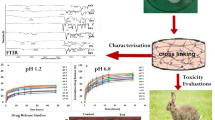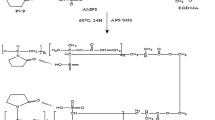Abstract
Pluronic F127-co-poly(acrylic acid) smart gels were fabricated by using ethylene glycol dimethacrylate (EGDMA) as cross-linker. Free radical polymerization in aqueous medium was initiated by using co-initiators ammonium persulfite (APS) and sodium hydrogen sulfate (SHS). Prepared gels were characterized for pH-sensitivity and in-vitro properties. In addition effect of reactant contents on developed formulation were evaluated by swelling behavior and drug release profile. FTIR spectra revealed the formation of new polymeric network between reactant contents. SEM assay shows rough structure of polymeric matrix which increases the surface area of gel and enhance ability to uptake fluid. TGA and DSC verified that fabricated polymeric smart gels were more thermodynamically stable than pure components. Gel fractions were increased with increase in polymer, monomer and cross-linker contents. Swelling study showed the pH dependent swelling behavior at pH 6.8 of PF127-co-AA polymeric gels. Release pattern of drug followed the first order kinetics, Higuchi and Korsmayer-Peppas models. Toxicity study was also conducted on rabbits and depicted non-toxic effects to biological system. Therefore, PF127-co-AA smart gel can be a potential candidate for the controlled delivery of Ivabradine HCl without any toxic effect.










Similar content being viewed by others
References
Soares GA et al (2013) Blends of cross-linked high amylose starch/pectin loaded with diclofenac. Carbohydr Polym 91(1):135–142
Malaterre V et al (2009) Benchtop-magnetic resonance imaging (BT-MRI) characterization of push–pull osmotic controlled release systems. J Control Release 133(1):31–36
Tao SL, Desai TA (2003) Microfabricated drug delivery systems: from particles to pores. Adv Drug Deliv Rev 55(3):315–328
Freiberg S, Zhu X (2004) Polymer microspheres for controlled drug release. Int J Pharm 282(1):1–18
Van Tomme SR, Storm G, Hennink WE (2008) In situ gelling hydrogels for pharmaceutical and biomedical applications. Int J Pharm 355(1):1–18
Ahmed EM (2015) Hydrogel: preparation, characterization, and applications. J Adv Res 6:105–121
Gupta P, Vermani K, Garg S (2002) Hydrogels: from controlled release to pH-responsive drug delivery. Drug Discov Today 7(10):569–579
Soares PA et al (2015) Development and characterization of a new hydrogel based on galactomannan and κ-carrageenan. Carbohydr Polym 134:673–679
Peppas N et al (2000) Hydrogels in pharmaceutical formulations. Eur J Pharm Biopharm 50(1):27–46
Sohail M et al (2014) Synthesis and characterization of graft PVA composites for controlled delivery of valsartan. Lat Am J Pharm 33(8):1237–1244
Ganji F, Vasheghani-Farahani E (2009) Hydrogels in controlled drug delivery systems. Iran Polym J 18(1):63–88
Anwar H et al (2017) Alginate-polyvinyl alcohol based interpenetrating polymer network for prolonged drug therapy, optimization and in-vitro characterization. Carbohydr Polym 166:183–194
Elliott JE et al (2004) Structure and swelling of poly (acrylic acid) hydrogels: effect of pH, ionic strength, and dilution on the crosslinked polymer structure. Polymer 45(5):1503–1510
Escobar-Chávez JJ et al (2006) Applications of thermo-reversible pluronic F-127 gels in pharmaceutical formulations. Journal of Pharmacy & Pharmaceutical Sciences 9(3):339–358
Chun KW et al (2005) Controlled release of plasmid DNA from photo-cross-linked pluronic hydrogels. Biomaterials 26(16):3319–3326
Yuan Xiong X, Chiu Tam K, Huat Gan L (2006) Synthesis and thermally responsive properties of novel pluronic F87/polycaprolactone (PCL) block copolymers with short PCL blocks. J Appl Polym Sci 100(5):4163–4172
Bromberg L (1998) Polyether-modified poly (acrylic acid): synthesis and applications. Ind Eng Chem Res 37(11):4267–4274
Minhas MU et al (2013) Synthesis of chemically cross-linked polyvinyl alcohol-co-poly (methacrylic acid) hydrogels by copolymerization; a potential graft-polymeric carrier for oral delivery of 5-fluorouracil. DARU Journal of Pharmaceutical Sciences 21(1):44
Sohail M et al (2015) Controlled delivery of valsartan by cross-linked polymeric matrices: synthesis, in vitro and in vivo evaluation. Int J Pharm 487(1):110–119
Najib N, Suleiman M (1985) The kinetics of drug release from ethylcellulose solid dispersions. Drug Dev Ind Pharm 11(12):2169–2181
Desai SJ, Simonelli A, Higuchi W (1965) Investigation of factors influencing release of solid drug dispersed in inert matrices. J Pharm Sci 54(10):1459–1464
Higuchi T (1963) Mechanism of sustained-action medication. Theoretical analysis of rate of release of solid drugs dispersed in solid matrices. J Pharm Sci 52(12):1145–1149
Peppas, N., Analysis of Fickian and non-Fickian drug release from polymers. 1985
Barkat K et al (2017) Development and characterization of pH-responsive polyethylene glycol-co-poly (methacrylic acid) polymeric network system for colon target delivery of oxaliplatin: its acute oral toxicity study. Adv Polym Technol
Innocenzi P et al (2009) Evaporation-induced crystallization of pluronic F127 studied in situ by time-resolved infrared spectroscopy. J Phys Chem A 114(1):304–308
Hu H et al (2012) Engineering of a novel pluronic F127/graphene nanohybrid for pH responsive drug delivery. J Biomed Mater Res A 100(1):141–148
Ma W-D et al (2008) Pluronic F127-g-poly (acrylic acid) copolymers as in situ gelling vehicle for ophthalmic drug delivery system. Int J Pharm 350(1):247–256
Wang L et al (1997) A new approach for the fabrication of an alternating multilayer film of poly (4-vinylpyridine) and poly (acrylic acid) based on hydrogen bonding. Macromol Rapid Commun 18(6):509–514
Huang Y et al (2012) Preparation and swelling properties of graphene oxide/poly (acrylic acid-co-acrylamide) super-absorbent hydrogel nanocomposites. Colloids Surf A Physicochem Eng Asp 401:97–106
Kim K-S, Park S-J (2010) Effect of porous silica on sustained release behaviors of pH sensitive pluronic F127/poly (acrylic acid) hydrogels containing tulobuterol. Colloids Surf B: Biointerfaces 80(2):240–246
Swapna G, Srikanth S, Rao UM (2015) Formulation and in-vitro evaluation of Ivabradine buccal tablets. Int J Trends Pharm Life Sci 1(4):457–470
Majeed A et al (2017) Development and evaluation of ivabradine hcl-loaded polymeric microspheres prepared with eudragit l100-55 (methacrylic acid-ethyl acrylate copolymer) and ethyl cellulose for controlled drug release. Acta Poloniae Pharmaceutica-Drug Research 74(2):565–578
Jin J et al (2011) Phase control of ordered mesoporous carbon synthesized by a soft-templating method. Colloids Surf A Physicochem Eng Asp 384(1):58–61
Tanaka S et al (2009) Synthesis of ordered mesoporous carbon films, powders, and fibers by direct triblock-copolymer-templating method using an ethanol/water system. Carbon 47(11):2688–2698
Park S et al (2011) Preparation of silver nanoparticle-containing semi-interpenetrating network hydrogels composed of pluronic and poly (acrylamide) with antibacterial property. J Ind Eng Chem 17(2):293–297
Rokhade AP et al (2007) Novel hydrogel microspheres of chitosan and pluronic F-127 for controlled release of 5-fluorouracil. J Microencapsul 24(3):274–288
Rajera R et al (2011) Niosomes: a controlled and novel drug delivery system. Biol Pharm Bull 34(7):945–953
Hussain T, Ranjha NM, Shahzad Y (2011) Swelling and controlled release of tramadol hydrochloride from a pH-sensitive hydrogel. Designed Monomers and Polymers 14(3):233–249
Mawad D, Foster JL, Lauto A (2008) Drug-delivery study and estimation of polymer–solvent interaction parameter for bisacrylate ester-modified Pluronic hydrogels. Int J Pharm 360(1):231–235
Xiong X, Tam K, Gan L (2006) Polymeric nanostructures for drug delivery applications based on pluronic copolymer systems. J Nanosci Nanotechnol 6(9–1):2638–2650
Sohail K et al (2014) pH-sensitive polyvinylpyrrolidone-acrylic acid hydrogels: impact of material parameters on swelling and drug release. Brazilian Journal of Pharmaceutical Sciences 50(1):173–184
Lu Y et al (2009) Poly (vinyl alcohol)/poly (acrylic acid) hydrogel coatings for improving electrode–neural tissue interface. Biomaterials 30(25):4143–4151
Ramelow US, Pingili S (2010) Synthesis of ethylene glycol Dimethacrylate-methyl methacrylate copolymers, determination of their reactivity ratios, and a study of dopant and temperature effects on their conductivities. Polymers 2(3):265–285
Gong C et al (2009) Biodegradable in situ gel-forming controlled drug delivery system based on thermosensitive PCL–PEG–PCL hydrogel. Part 2: sol–gel–sol transition and drug delivery behavior. Acta Biomater 5(9):3358–3370
Changez M et al (2003) The effect of composition of poly (acrylic acid)–gelatin hydrogel on gentamicin sulphate release: in vitro. Biomaterials 24(4):527–536
dos Santos J-FR et al (2008) Poly (hydroxyethyl methacrylate-co-methacrylated-β-cyclodextrin) hydrogels: synthesis, cytocompatibility, mechanical properties and drug loading/release properties. Acta Biomater 4(3):745–755
Akash MSH et al (2012) Sustained delivery of IL-1Ra from pluronic F127-based thermosensitive gel prolongs its therapeutic potentials. Pharm Res 29(12):3475–3485
Paloma M et al (2003) Release of amoxicillin from polyionic complexes of chitosan and poly (acrylic acid). Study of polymer/polymer and polymer/drug interactions within the network structure. Biomaterials 24(8):1499–1506
Zarzycki R, Modrzejewska Z, Nawrotek K (2010) Drug release from hydrogel matrices. Ecol Chem Enginer S 17:117–136
Author information
Authors and Affiliations
Corresponding author
Additional information
Publisher’s note
Springer Nature remains neutral with regard to jurisdictional claims in published maps and institutional affiliations.
Rights and permissions
About this article
Cite this article
Nasir, N., Ahmad, M., Minhas, M.U. et al. pH-responsive smart gels of block copolymer [pluronic F127-co-poly(acrylic acid)] for controlled delivery of Ivabradine hydrochloride: its toxicological evaluation. J Polym Res 26, 212 (2019). https://doi.org/10.1007/s10965-019-1872-8
Received:
Accepted:
Published:
DOI: https://doi.org/10.1007/s10965-019-1872-8




